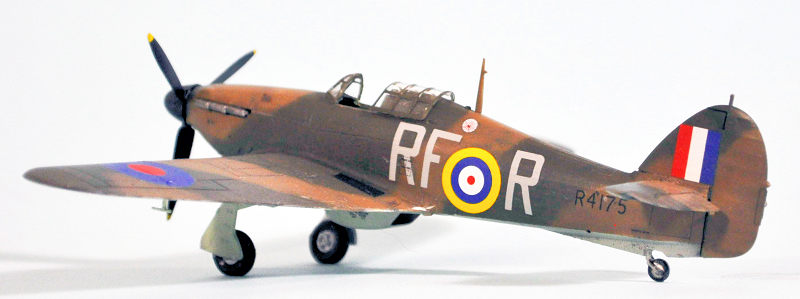
Arma Hobby 1/72 Hurricane I/IIc
| KIT #: | 70019/35 |
| PRICE: | ~$22-25.00 |
| DECALS: | Yes |
| REVIEWER: | Tom Cleaver |
| NOTES: |

| HISTORY |
First appearing in 1935, the Hawker Hurricane was the first modern monoplane fighter to equip the RAF, and was one of only three RAF aircraft to operate in first-line service from the first day of the Second World War to the last. (The other two being the Spitfire and the Swordfish)
Though the Spitfire gained the glory in the Battle of Britain, it was the tough Hurricane that won the fight. Three-fifths of the squadrons of RAF's Fighter Command were mounted on Sidney Camm's fighter that summer of 1940. Though outperformed by the Bf-109E, the Hurricane had the benefit of being “primitive” enough in its construction that shot-down Hurricanes could be quickly repaired and returned to service, which was the RAF “secret” that really won the Battle of Britain - fully 60 percent of the Hurricanes shot down over England that summer were repaired and returned to operational use during the battle, a fact that Goering's Luftwaffe missed as they confidently predicted that on September 15, 1940, there would be no RAF fighters over London. It was a scandal when reports came out that production Hurricane I's could barely make 305 mph at 10,000 feet - the height at which most combat occurred - and that the airplane could not be flown over 20,000 feet, the altitude from which the Messerschmitts dove out of the sun on their targets.
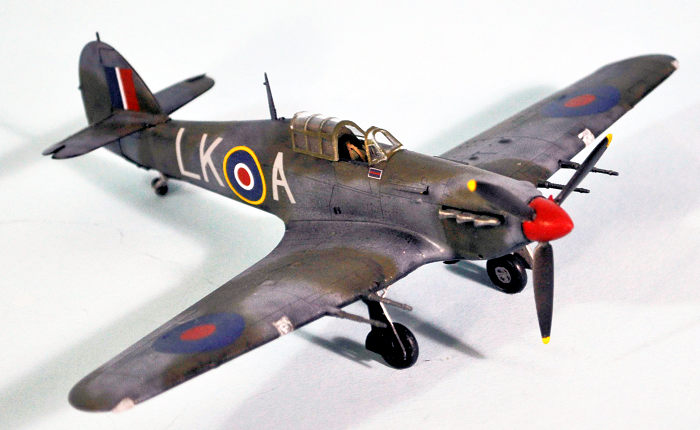 Outclassed or not, the Hurricane was there when it was needed, in
numbers sufficient to change the outcome of a battle nearly everyone
expected Britain to lose. As such, it is a model deserving of a place of
high distinction in any collection.
Outclassed or not, the Hurricane was there when it was needed, in
numbers sufficient to change the outcome of a battle nearly everyone
expected Britain to lose. As such, it is a model deserving of a place of
high distinction in any collection.
Josef Frantisek:
By the time Czech pilot Josef Frantiszek arrived in Britain on June 21, 1940, he had seen action in Poland and France. Having arrived with several Polish fliers, he was sent to Blackpool to report to the Polish Air Force Depot; eventually he was given the rank of Flight Sergeant and assigned to 303 Squadron, a new unit made up almost entirely of Polish pilots.
On August 30, 1940, the pilots of 303 were conducting a training flight with their Commanding Officer over Hertfordshire, when they sighted a large formation of enemy aircraft below. Two of the Polish pilots reported the sighting to their Flight Leader and immediately peeled away to attack the German aircraft, shooting down a Bf-110 in the ensuing combat. Back at Northolt, they were severely reprimanded, before the CO went on to congratulate them on their victory. The next day, 303 Squadron became operational; on their first day of operations, they shot down six Luftwaffe fighters in a 15 minute fight, without suffering loss.
That day proved to be Fighter Command’s costliest and arguably the closest the RAF came to defeat. Despite their relatively late entry into the fighting, the Polish airmen of 303 Squadron became the most successful squadron of the entire Battle of Britain, scoring nearly three times the number of victories posted by other RAF squadrons. In just 42 days of fighting, 303 was credited with 126 enemy aircraft destroyed, with nine of the pilots becoming aces.
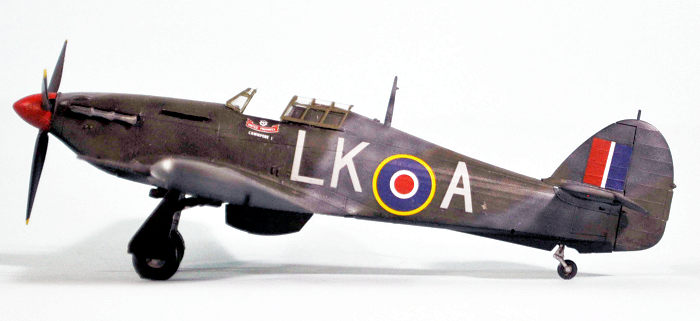 Josef Frantiszek possessed an extremely aggressive fighting style
and was even described as a “lone wolf,” something that did not ingratiate
him to either his commanding officers, or his squadron mates. He scored his
first victory on September 2, 1940. Twenty-eight days later, he was credited
with 17 confirmed victories, making him both the top-scoring pilot in 303
Squadron and the most successful RAF pilot of the Battle of Britain. Flying
Hawker Hurricane Mk.I R4175 RF-R to claim seven of these victories, this
would prove to be his most productive fighter
Josef Frantiszek possessed an extremely aggressive fighting style
and was even described as a “lone wolf,” something that did not ingratiate
him to either his commanding officers, or his squadron mates. He scored his
first victory on September 2, 1940. Twenty-eight days later, he was credited
with 17 confirmed victories, making him both the top-scoring pilot in 303
Squadron and the most successful RAF pilot of the Battle of Britain. Flying
Hawker Hurricane Mk.I R4175 RF-R to claim seven of these victories, this
would prove to be his most productive fighter
The constant combat flying took its toll on many pilots, and Frantiszek was no exception. His squadron comrades noticed a distinct change in his demeanor by the beginning of October; he seemed restless and almost afraid to stay on the ground, volunteering for every combat sortie or standing patrol he could get himself on. On October 8, patrolling over southern England, Frantiszek inexplicably broke formation and headed off at high speed; this was the last time he was seen by anyone until his body was found later lying next to his wrecked Hurricane in a field near Ewell in Surrey, with the cause of the crash being just one of the many mysteries of the Second World War.
| THE KIT |
Arma Hobby began as an aftermarket resin manufacterer, graduating to limited-run resin kits with uniform high quality, and now producing limited-run injection molded kits. As with many “limited run” kits from Eastern Europe, these are high-quality models. Surface detail is superb and would be acceptable in a 1/48 kit. In fact, these Hurricane kits have the best fuselage fabric detail of any Hurricane kit. The cockpits are not as detailed as the Airfix 1/48 kit, but in 1/72 what is there is more than acceptable.
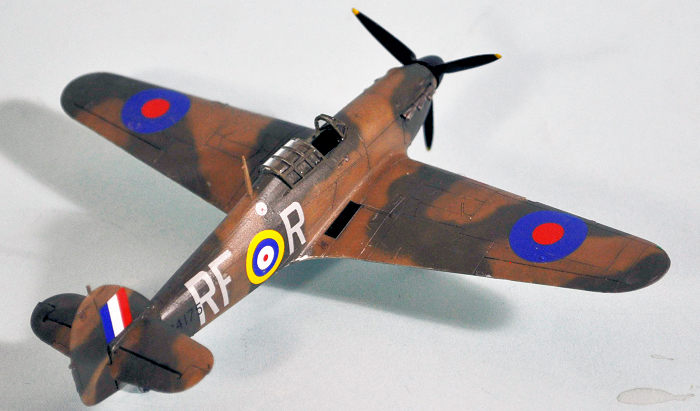 The kits are issued in a “standard” kit which lacks photoetch detail and
the number of markings options, and the “expert” kits, which have both photoetch
detail and several markings options. Both of these review kits were “expert”
kits.
The kits are issued in a “standard” kit which lacks photoetch detail and
the number of markings options, and the “expert” kits, which have both photoetch
detail and several markings options. Both of these review kits were “expert”
kits.
The two kits are different as regards their fuselages, wings, and props, which accurately represent the Hurricane I and Hurricane IIc, while sharing other parts. Being Polish kits, the markings options are all of aircraft flown in various squadrons by Polish pilots. The Hurricane I has national insignia in both the pre-war colors associated with Hurricanes produced by Gloster, and the more common “combat colors”, with markings for Battle of Britain aircraft and a SAAF Hurricane from the Ethiopian campaign. The Hurricane IIc has markings for night fighter aircraft, with two options for BE500, a day fighter Hurricane IIc and a tropical version from the Desert Air Force. Each sheet has all the stenciling. The canopies are a bit thick, but they are molded with “open” and “closed” options. The control surfaces are separate.
| CONSTRUCTION |
These kits are simple to build and the instructions are clear. After building the Hurricane I, I determined that the photoetch parts other than the seatbelts were not necessary to get a model as detailed as I wanted.
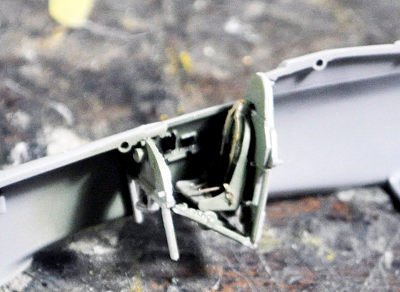 I began with the wing sub-assembly in each case, assembling the wheel
well, then the wing, then attaching the radiator and landing gear after the
wheel well and gear were painted aluminum.
I began with the wing sub-assembly in each case, assembling the wheel
well, then the wing, then attaching the radiator and landing gear after the
wheel well and gear were painted aluminum.
The fuselages were assembled using the decals for the instrument panels and photoetch seatbelts. The cockpit parts were painted before assembly.
I then attached the fuselage and wing, then attached the horizontal stabilizers with the elevators drooped, finishing off with attaching the rudder.
With care in assembly, no filler was needed anywhere.
| COLORS & MARKINGS |
I used Xtracrylix RAF Dark Earth, Dark Green and Sky, applied freehand with my Paasche-H using a #1 tip.
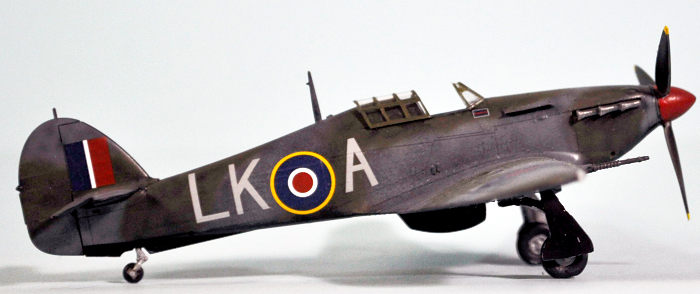 The Hurricane IIc was painted overall with Tamiya X-18 Semi-gloss Black,
with a “roughly applied” (per the painting instructions) field-painted day
fighter approximation of the A-scheme, using Tamiya XF-82 Ocean Grey and XF-81
RAF Dark Green.
The Hurricane IIc was painted overall with Tamiya X-18 Semi-gloss Black,
with a “roughly applied” (per the painting instructions) field-painted day
fighter approximation of the A-scheme, using Tamiya XF-82 Ocean Grey and XF-81
RAF Dark Green.
Once the models were painted, I gave each a coat of clear gloss.
I decaled the Hurricane I as Josef Frantisek’s 303 Squadron R4175/RF0-R, a Gloster-built Hurricane, and the Hurricane IIc as BE500 of 87 Squadron flown by S/L Denis Smallwood during the Dieppe Raid in August 1942. Each model was given a coat of clear flat after the decals had set up and the residue was cleaned off.
I opened the canopies and attached them, then attached the wheels to the landing gear and the props and exhausts.
| CONCLUSIONS |
I think these Arma Hobby Hurricanes, which come in different releases with different markings options, are the best, most accurate Hurricane models available in 1/72, beating the new-release Airfix Hurricanes I previously awarded first place to. These kits are not cheap for 1/72, but “you get what you pay for.” The Airfix kits are still the best 1/72 Hurricanes for price, and their “ragwing” release is the only one with that option in any scale by a major manufacturer.
Recommended to anyone who likes the Hurricane. Thanks to my government-paid, bureaucrat-run medical care (the VA) for restoring my eyes and allowing me to return to 1/72 modeling.
Back to the Main Page Back to the Previews Index Page
Back to the Previews Index Page